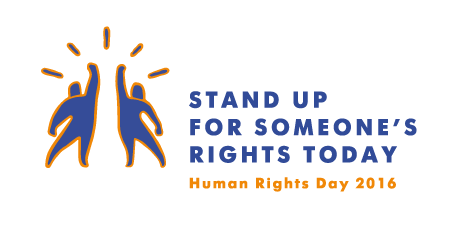What do the pictures have in common?
Present the following pictures to your students and ask them what they have in common. What is the main idea behind them? What are they in reference to?
Key: They are all in connection with human rights and Human Rights Day. 1) Malala Yousafzai is a Pakistani activist and Nobel Prize winner known for her human rights advocacy for female education. 2) Eleanor Roosevelt was an American politician and the chair of the committee that adopted the Universal Declaration of Human Rights in 1948. 3) The Empire State Building in blue in honour of Human Rights Day on 10 December every year.
Pictures: www.google.com
Human Rights Day
Once students have the solution, tell them about Human Rights Day briefly. According to the UN, “Human Rights Day is observed every year on 10 December. It commemorates the day on which, in 1948, the United Nations General Assembly adopted the Universal Declaration of Human Rights” to defend and promote human rights.
Speed dating
Divide the class into two groups and ask them to form two concentric circles. The students in the circles should face each other, i.e. everyone should have a partner standing opposite them. Tell them that they are going to get questions and have 2 minutes to discuss them. After 2 minutes, those standing in the outer circle will move to the right, have a new partner, and discuss a new question. (You may choose the inner circle and the other direction, of course.) The activity continues for 4-5 questions, depending on how much time you have.
Some of the questions are from the video the students are going to watch later.
- What are the basic human rights?
- Who chooses them?
- What is the most important human right for you?
- Do all people have equal rights in the world?
- …
Checking answers
Play the video until 2:24 and let students check their predictions to some of the questions. Conduct open-class feedback.
What’s the word?
Give students the transcript of the video excerpt they have just seen with some of the main words paraphrased below it. Ask students to find these words in the text.
The idea of human rights is that each one of us, no matter who we are or where we are born, is entitled to the same basic rights and freedoms. Human rights are not privileges and they cannot be granted or revoked. They are inalienable and universal. That may sound straightforward enough, but it gets incredibly complicated as soon as anyone tries to put the idea into practice. What exactly are the basic human rights? Who gets to pick them? Who enforces them, and how?
The history behind the concept of human rights is a long one. Throughout the centuries and across societies, religions, and cultures, we have struggled with defining notions of rightfulness, justice, and rights. But one of the most modern affirmations of universal human rights emerged from the ruins of World War II with the creation of the United Nations. The treaty that established the UN gives as one of its purposes to reaffirm faith in fundamental human rights. And with the same spirit, in 1948, the UN General Assembly adopted the Universal Declaration of Human Rights. This document, written by an international committee chaired by Eleanor Roosevelt, lays the basis for modern international human rights law.
The declaration is based on the principle that all human beings are born free and equal in dignity and rights. It lists 30 articles recognising, among other things, the principle of non-discrimination and the right to life and liberty. It refers to negative freedoms, like the freedom from torture or slavery, as well as positive freedoms, such as the freedom of movement and residence. It encompasses basic civil and political rights, such as freedom of expression, religion, or peaceful assembly, as well as social, economic, and cultural rights, such as the right to education and the right to freely choose one’s occupation and be paid and treated fairly. The declaration takes no sides as to which rights are more important, insisting on their universality, indivisibility, and interdependence. And in the past decades, international human rights law has grown, deepening and expanding our understanding of what human rights are, and how to better protect them.
- a special advantage that is given only to one person or a group of people: ________________
- something that cannot be taken from you: ________________
- to make people obey a rule or law: ________________
- a formal written agreement between two or more countries or governments: ________________
- a part of a law or legal agreement that deals with a particular point: ________________
- to formally state an opinion or belief, especially when someone expressed a doubt: ________________
- the fact of being respected or deserving respect: ________________
- an act of deliberately hurting someone in order to force them to tell you something or to punish them: ________________
- the meeting of a group of people for a particular purpose: ________________
- the fact of not being able to be separated: ________________
Key: privilege / inalienable / enforce / treaty / article / reaffirm / dignity / torture / assembly / indivisibility
Note: The definition come from http://www.ldoceonline.com/
Word formation
After clarifying the meaning and the pronunciation of the words, put the students into groups of 3. Each group gets 2 words from the list above and a dictionary (or they use their smartphones) and is asked to look for some other forms of the words, such as adjectives, nouns, etc. For instance, the first group can find “privileged” or “privilege (V)” and “inalienability” or “inalienably” etc. Discuss the findings with the whole class.
Discussion
After working with the language, students keep on working in the groups of three. Each group receives 5-6 questions (again, from the video) that they need to discuss. Conduct open class feedback in the end and play the rest of the video to see what it says. Ask for feedback again.
- Why are human rights abused and ignored time and time again all over the world?
- Can you think of any positive and negative aspects of the UDHR?
- Are human rights really universal?
- Are human rights changing?
- Should there be a right to digital privacy?
- …
Takeaway
At the end of the session, ask students to finish the following sentences.
- Today, I learnt that…
- I’d like to know more about…
- Three new words/expressions I’m going to use are…
Optional task
Ask students to read about what happened to Malala and how she got to hold a speech at the UN and became a Nobel Prize laureate. Interested students can summarise their findings in the next lesson.





The UDHR, briefly presented in the video above, is available in ‘child-friendly language’ here: pp. 289-90
http://www.eycb.coe.int/compasito/chapter_6/pdf/1.pdf
==>Learners at higher A2//low B1 level (and above) can be introduced that.
The UDHR in its full complex language follows: pp. 291-93
The ECHR (European Convention of Human Rights, ‘child-friendly version’) follows:
pp. 294-95
The CRC (Convention on the Rights of the Child, ‘child-friendly version’) follows: pp. 296-98
Only there in Article 30/CRC do we hear something about the right of a child to their own home language: “You have a right to learn and use the traditions, religion
and language of your family, whether or not these are shared by most people in your country.” THIS IS NOT INCLUDED IN THE UDHR OR ECHR. ‘learn and use’ is of course a very open concept. Do kids have the right to develop literacy in their L1? A huge question.
The CRC in its original complex wording follows (pp. 299-307). A glossary and ‘useful sources follow from p. 308.
The right to cost-free and equal education seems to be mentioned only for primary education in the UDHR. What about free secondary and particularly higher education? This has become a major issue in numerous countries, including the US, where tertiary education is becoming unaffordable or linked to huge loans for a rapidly growing multitude of students. What do your own students think?
The UDHR declares ‘right to work’ inalienable but does not declare the ‘right to a guaranteed job’, another major issue in political economy. A variant of that is the ‘right to a guaranteed job at a livable income in your own country’ the right not to be forced into migration. How do students respond to such a notion? ‘Utopian’?